January 17, 2025
Air Date: January 17, 2025
FULL SHOW
SEGMENTS
Green Light for State Climate Cases
View the page for this story
Facing huge costs for climate adaptation and disaster recovery, some states and localities are suing fossil fuel companies for damages. The U.S. Supreme Court recently declined an attempt to block these lawsuits, and Vermont Law and Graduate School Emeritus Professor Pat Parenteau joins Host Aynsley O’Neill to explain the significance of some of them proceeding to trial. (09:28)
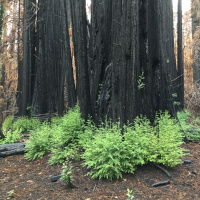
Redwood Rebirth After Fire
View the page for this story
Nearly all the tall coast redwoods in California’s Big Basin Redwoods State Park burned in a 2020 wildfire. But within a few months, the charred trunks had grown a fuzz of healthy green shoots. A paper documents how the trees were able to regenerate using energy reserves stored for many decades. Lead author Drew Peltier teaches at the University of Nevada – Las Vegas and joins Host Jenni Doering to explain the science behind this stunning recovery. (12:40)
La Niña and El Niño Dance
View the page for this story
With the recent appearance of a flip from an El Niño back to a weak La Niña climate pattern, Hosts Aynsley O’Neill and Jenni Doering discuss what it could mean for U.S. and world weather patterns, as well as how the El Niño / La Niña oscillation is changing in the era of climate disruption. (03:32)
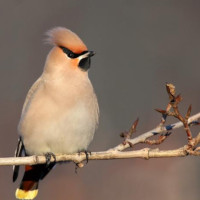
BirdNote®: Waxwing Nightlight
View the page for this story
Waxwings were once believed to glow in the dark, and Pliny the Elder reported that their feathers were said to “shine like flames” in the dark forests of central Europe. That is, until one sixteenth-century Italian birder decided to take a closer look, says BirdNote®’s Mary McCann. (02:03)
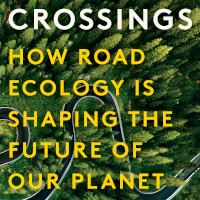
Crossings: How Road Ecology is Shaping the Future of Our Planet
View the page for this story
The many millions of miles of roads that crisscross our planet block everything from bears to beetles from safely moving through habitats. But new wildlife crossings like overpasses and underpasses are helping reconnect animals with the landscape. Journalist Ben Goldfarb joins Host Jenni Doering to discuss his book Crossings: How Road Ecology is Shaping the Future of Our Planet. (18:33)
Show Credits and Funders
Show Transcript
250117 Transcript
HOSTS: Jenni Doering, Aynsley O’Neill
GUESTS: Ben Goldfarb, Pat Parenteau, Drew Peltier, Kevin Trenberth
REPORTERS: Mary McCann
[THEME]
O’NEILL: From PRX – this is Living On Earth.
[THEME]
O’NEILL: I’m Aynsley O’Neill
DOERING: And I’m Jenni Doering.
States and cities get a green light to proceed with climate cases against fossil fuel companies.
PARENTEAU: Collectively, with all of these different cases, we really are talking about billions, and we may be talking about the potential for bankruptcy in these cases. That's one thing that the oil companies are arguing is what you're gonna ultimately do is drive us into bankruptcy.
O’NEILL: Also, building wildlife crossings across roads leads to all kinds of unusual questions.
GOLDFARB: How does a moose comprehend traffic? What sort of tunnel appeals to a mink? Why do grizzly bears prefer crossing over highways while black bears go under? These questions had empirical answers, but they also required ecologists to think like wild animals -- Empathy manifested as science.
O’NEILL: That and more, this week on Living on Earth, stick around!
[NEWSBREAK MUSIC: Boards of Canada “Zoetrope” from “In A Beautiful Place Out in The Country” (Warp Records 2000)]
[THEME]
Green Light for State Climate Cases
If Hawai’i and other states win their cases against the fossil fuel companies, the lawsuits could open up funding opportunities for communities that need to prepare for an increase in extreme weather events, such as forest fires. Pictured: the deadly August 2023 wildfire in Maui, as seen from the International Space Station. (Photo: NASA Johnson, Flickr, CC BY-NC-ND 2.0)
DOERING: From PRX and the Jennifer and Ted Stanley Studios at the University of Massachusetts, Boston, this is Living on Earth. I’m Jenni Doering.
O’NEILL: And I’m Aynsley O’Neill.
In 2021, Honolulu, Hawai’i brought a lawsuit against a group of fossil fuel companies over the climate and environmental impacts of burning oil and gas. The case potentially makes the companies liable for over a billion dollars’ worth of damages. Nearly forty similar cases are now working their way through state courts across the country. As you might imagine, the fossil fuel industry defendants aren’t happy about this. And they appealed to the U.S. Supreme Court to block the Honolulu case from forcing the companies to turn over records and go through a trial. But the justices declined the fossil fuel industry’s requests and are allowing the cases to move forward in the lower courts for now. The court’s restraint is a big deal for climate litigation, says Pat Parenteau, former EPA Regional Counsel and Emeritus Professor at Vermont Law and Graduate School. And he considers the high court’s willingness to let the states and localities seek climate redress in the courts a bright spot as we head into the start of a second Trump administration which is forecast to favor federal climate inaction. We started off with the back story on the Hawaiian lawsuit.
PARENTEAU: So, this is a lawsuit filed by the city of Honolulu in Hawaii, of course, and it's filed against what we call the major oil companies, Exxon, Sunoco and others. And it's seeking to recover the costs from climate damage that states like Hawaii and cities like Honolulu are incurring, of course, storms and droughts and heat and so forth and the money is to be used for adaptation. It's not one of the typical climate cases where you're trying to reduce emissions. It's a case where saying the emissions are continuing and they're doing a lot of damage, and the companies that are responsible for marketing and selling the products that are causing climate change need to bear some of the costs, not all of the costs, but some of the costs of dealing with the impacts from climate change.
Downtown Honolulu. Honolulu first brought the case against a collection of fossil fuel companies in 2021. (Photo: Edmund Garman, Flickr, CC BY 2.0)
O'NEILL: There's about 40 similar cases around the country. How does this case differ from say, the case in Massachusetts alleging that Exxon misled consumers and investors about climate risks?
PARENTEAU: Right. So, there are some similarities, that particular point of deception is present in the Honolulu case as well, but Honolulu is arguing a lot of other theories, including things like public nuisance and strict liability, whereas the Massachusetts case is really focused on that consumer protection aspect and on false advertising. And what it's seeking in Massachusetts is penalties and, of course, an acknowledgement of the company that they haven't been entirely forthcoming and honest about the way they've marketed their products, and also something called disgorgement of profits, ill-gotten gains, as we call it in the law. So, they're similar in some ways, but also very different in terms of the amount of money that's being sought.
O'NEILL: Well so Pat, what are the fossil fuel companies responses to these allegations and claims?
PARENTEAU: Right. So, the oil companies are saying a number of things. First of all, they're saying “the only remedy for climate change is really through the legislative process”. That's one of their main arguments, that the courts shouldn't be involved in adjudicating controversies over a global problem where pretty much everybody's responsible. That's another one of their arguments, and where the solutions are really difficult and complicated, because we can't stop burning fossil fuels overnight, and it's going to take a long time to transition away to other sources of energy, and it's going to take money and investments and policies. And these cases, they argue, don't accomplish any of that. They're trying to punish the oil companies. They're trying to single out individual companies for a problem that everybody is responsible for, globally. And that the states shouldn't be bringing these lawsuits because these are trans boundary pollution issues. They don't involve any one state. They don't even involve any one country. Which is all true, but what they're not willing to accept is that they do bear some responsibility for marketing products and, of course, reaping significant profits over time for a product it has turned out to be causing pollution that's resulting in the kinds of horrendous scenes that we're seeing today in Los Angeles.
The Supreme Court decision not to hear Honolulu’s case against the oil companies leaves more time for Honolulu to gather evidence against the oil companies as the case proceeds through the lower courts. (Photo: Kjetil Ree, Wikimedia Commons, CC BY-SA 3.0)
O'NEILL: Now, Pat, what do you make of the Supreme Court decision to not take the case? You know, is it them saying “it's better left to the states”, or is it kind of a stop gap until it gets brought back to the Supreme Court?
PARENTEAU: Right? Yeah, they didn't say it's better left to this. They didn't say anything. They didn't say it was better left to the states. You know, when they deny review, they just issue an order and there's no opinion. So, the only thing you can say is this, that the Supreme Court didn't think that now was the time for them to just step into the controversy. It doesn't mean that the controversy has gone away, and it doesn't mean that the oil companies won't be back someday, once again, petitioning the Supreme Court to hear their arguments. It just means that for now, importantly, these cases can go to trial, and that means that the states and cities can put on the kind of evidence to show what exactly the companies have done and what the consequences have been and the costs that have been incurred as a result of that, states are going to have to prove all of this of course. Nothing's been proven yet, and no judgments have been issued yet. So, there's a long way to go before we have an actual verdict and a figure that the companies are gonna be forced to pay, and it's at that point I think where these cases, one of them, maybe Honolulu, maybe Massachusetts, maybe another one, will probably once again find its way back to the United States Supreme Court, because this ultimate question of whether federal law or state law governs these cases has to be answered by the Supreme Court, and it will take years before we get an answer to that.
O'NEILL: Pat, looking ahead if trial finishes and a judge rules in favor of Honolulu, what kind of long term implications would there be for the oil companies and the climate crisis overall?
PARENTEAU: Well, one consequence of a large verdict for over a billion dollars, which is what all of these cases are seeking. In some cases, in California, the estimate is so far that fires in LA have done $150 billion worth of damage, so they wouldn't be seeking the entire 150 billion. But collectively, with all of these different cases, we really are talking about billions, and we may be talking about the potential for bankruptcy in these cases, that's one thing that the oil companies are arguing, is what you're going to ultimately do is drive us into bankruptcy, and we don't know that that's true, but that's certainly an argument that they're making. So one of the major benefits of these cases would be to give the states and cities and counties another source of revenue to pay for what they're going to need to develop to adapt to these extreme weather events, and that's the ultimate goal of these cases, is to provide funding, not for everything that's required, but some contribution from the oil companies towards those costs, which otherwise will fall on the general taxpayers.
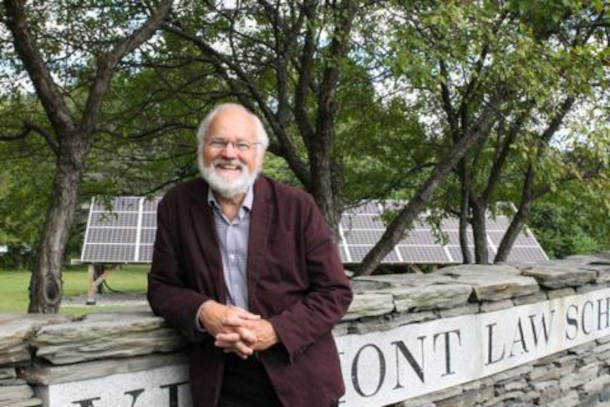
Pat Parenteau is a professor at Vermont Law and Graduate School. (Photo: Vermont Law and Graduate School)
O’NEILL: How big was this decision to not take the case?
PARENTEAU: Well, it was big, because if they had taken the case, at a minimum, it would have frozen all these cases in place for over a year, because it takes the Supreme Court a year from the time it agrees to review a case to all of the briefing that's required, an oral argument that wouldn't occur until the fall of this year, and a decision that probably wouldn't be issued until 2026. So, for that period of time, nothing would happen in all these cases, they'd be frozen. The other thing is, by taking the case, that would have been a signal that some, perhaps a majority, of the justices, thought that the goal companies were right, that these cases shouldn't proceed. And of course, that could have been a desk blow to these cases. Could have ended them all. If this court rules that these cases are preempted by federal law, they can't proceed. So by saying we're not hearing the case, they've allowed these cases to proceed to trial, where I think the states and counties and cities that are bringing these cases will be in a better position to argue to the Supreme Court down the road that these cases really are justified, once they've been able to prove all the damages, prove the deception, and make it more difficult for the court to say, no, the companies are completely immune from liability from these cases.
O'NEILL: Pat Parenteau is a former EPA Regional Council and emeritus professor at Vermont law and graduate school. Pat as always, thank you for taking the time with us today.
PARENTEAU: Thanks for having me.
Related links:
- Learn more about Pat Parenteau
- Read more about the Supreme Court’s recent decisions
- Explore documents related to Honolulu’s case against the fossil fuel companies
[MUSIC: BGM channel, “Rhythms of Waves” on Hawaiian Café~Happy Time~, BGMC Records]
DOERING: Coming up, after a wildfire burned nearly all of a redwood forest, the trees survived thanks to stored energy.
PELTIER: Some of these carbon reserves were on order of 50 to 100 years old. What that means is that carbon that was photosynthesized in the atmosphere potentially back in the 1940s is being used to regrow new leaves now after fire.
DOERING: Looking to nature for signs of hope amid the ashes - Stay tuned to Living on Earth.
ANNOUNCER: Support for Living on Earth comes from Sailors for the Sea and Oceana. Helping boaters race clean, sail green and protect the seas they love. More information @sailorsforthesea.org.
[CUTAWAY MUSIC: Time for Three with Jake Shimabukuro, “Happy Day” on Time for Three, by N. Kendall/arr.Bob Moose, Universal]
Redwood Rebirth After Fire
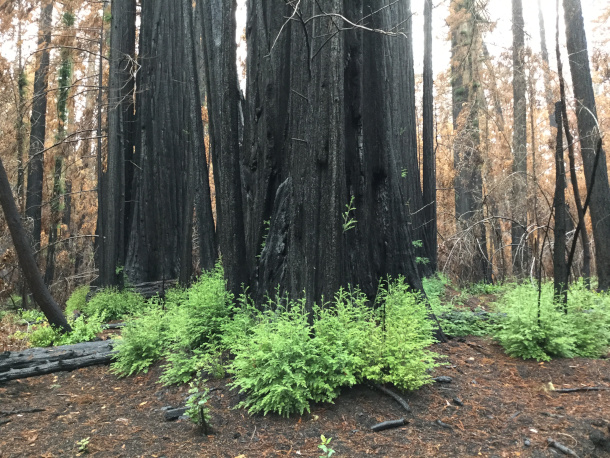
Sprouts at the base of a redwood tree in February 2021, 5 months after the 2020 CZU lightning complex fire. (Photo: Melissa Enright, co-author of the study “Old Reserves and Ancient Buds Fuel Regrowth of Coastal Redwood After Catastrophic Fire”)
O’NEILL: It’s Living on Earth, I’m Aynsley O’Neill.
DOERING: And I’m Jenni Doering.
In the wake of a massive wildfire, with everything in ashes, grief is a natural human response. But so are hope and resilience, and nature itself offers examples with the incredible recovery of some trees after fire. In the hot, dry summer of 2020, the CZU Lightning Complex Fire climbed straight into the heart of California’s Big Basin Redwoods State Park and up into the crowns of its iconic redwood trees, the tallest in the world.
[SFX and bites are from original broadcast of this story]
[FIRE SFX]
As the Park lay smoldering, rangers returned to see what remained.
RANGER 1: We finally make it to Park headquarters and there’s nothing left.
RANGER 2: The visitor’s center, the shop, residences, every vehicle in the fleet: gone. It’s all gone. And on top of that, you know, we talk about facilities like they’re structures, our trail system got hammered. We lost everything. You can say, we lost everything.
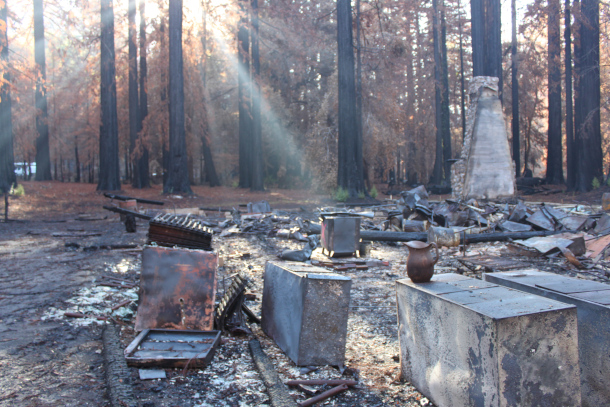
Study coauthor Lissy Enright took this photo of what remained of the Big Basin Redwoods State Park visitor center after the fire. (Photo: Lissy Enright)
DOERING: 97% of Big Basin had burned, including almost all its coast redwood trees.
Though many still stood, they were completely blackened all along their trunks, without any leaves intact. But incredibly, within a matter of months these redwoods began to grow fresh, bright green leaves. A group of Northern Arizona University scientists and other researchers visited the forest after the fire to learn its secret. Lead author Drew Peltier is an assistant professor in the School of Life Sciences at the University of Nevada Las Vegas, and he joined us to explain the science behind this stunning recovery.
PELTIER: Redwoods are really remarkable in that they have this ability to re sprout after fire. They have a lot of really neat fire adaptations; they have super thick bark at the base up to a foot thick. They're also just really, really tall, which helps to survive fires, because you're often above the flames. And all those things mean that they usually survive fire events, it seems like, and then they have this remarkable ability to regrow new leaves after the fire, even if they lose them all. And so, we were there to kind of study these resprouting individuals. And so, what you have now a couple years later, is what we've been calling these green telephone poles. So, these trees that have lost all their branches but then they've resprouted new foliage all on their stems. And so yeah, it's much less shady, it's a much different place than it was before the fire.
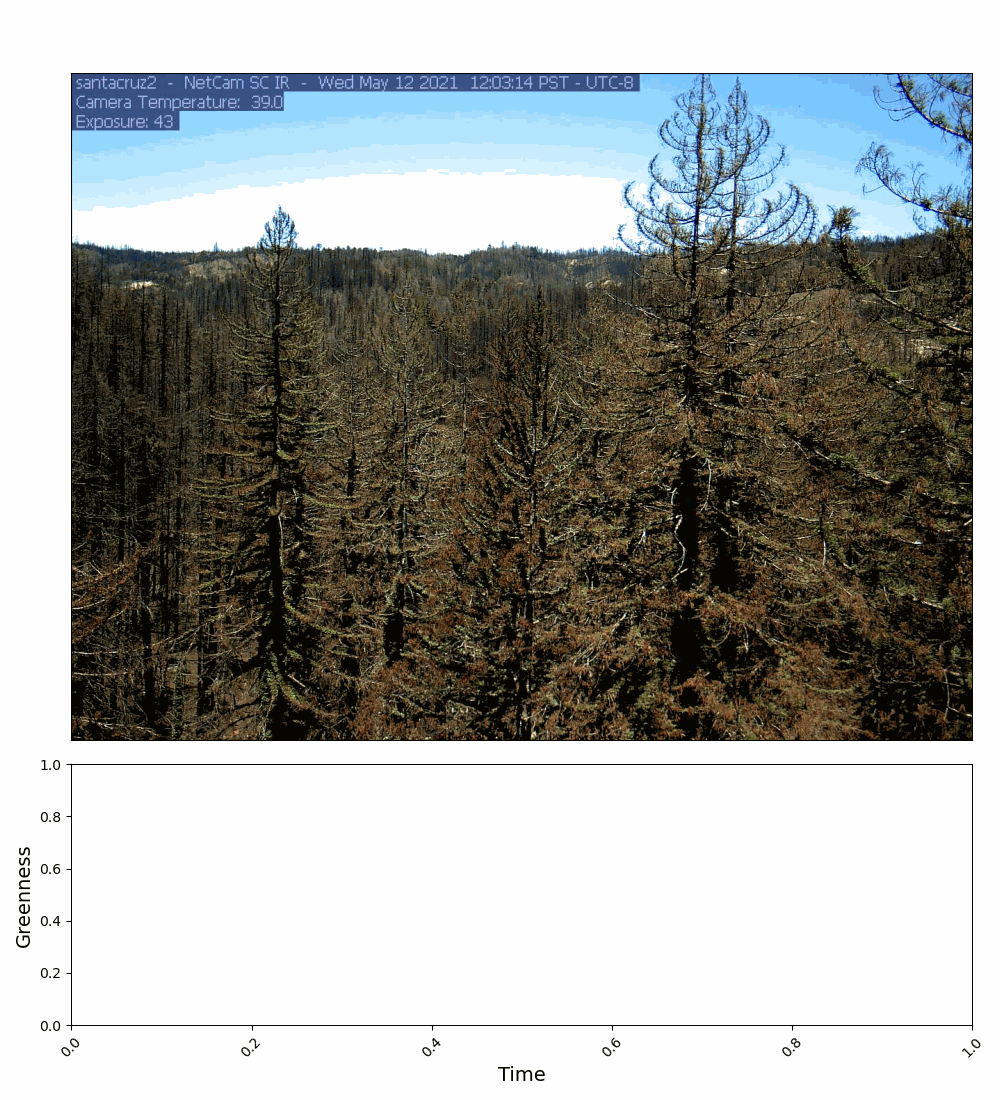
DOERING: It sounds like a really strange and different kind of forest to stand in. And you're talking about [LAUGH] green fuzzy telephone poles. So, the sprouts aren't just coming from the base of these trees.
PELTIER: No, these trees were resprouted from everywhere, from the roots from the stems, from branches if they if they managed to keep some of them. It's really kind of all over the streets; they produced a really gigantic amount of new foliage from these buds that they maintain. And so, it seems like they were really primed to very rapidly recover after this fire event.
DOERING: So, tell me about this transformation. I mean, given this devastation with, you know, this intense fire that went all the way up into the crown and burned all of the green needles for these trees to then have all of this new green growth. How is this happening?
PELTIER: Yeah, so the way that these trees do this is there are kind of two key adaptations that our study was really about. The first is that, well, they store a lot of energy because you need energy to grow. And when you don't have any leaves as a tree, you're not bringing in any new energy through photosynthesis. And so, one of the things we did was to look at sort of the age essentially, of those energy reserves or carbon reserves and basically, that's just in the form of things like sugars and starch. And so, by using this process called radiocarbon dating, we were able to estimate that some of these carbon reserves were on the order of 50 to 100 years old. So, to think about that another way, what that means is that carbon that was photosynthesize from the atmosphere, potentially back in the 1940s and 50s, is being used to regrow new leaves now after fire. So really, really long-term storage of, of energy. And kind of the second part of that is they have to have the anatomical tissues to grow these new leaves. And so the other really amazing thing that we found is when you look in the wood underneath these, these little sprouts coming out of the stem, what we saw was a line going all the way to the senator tree, which basically means that these sprouts arose from really ancient bud tissue, so buds that were sort of as old almost as the tree itself, which in some cases could be thousands of years. So, that's just sort of was shocking to us. It's this really long-term preservation of bud tissue. And those two things together really large amounts of very old carbon reserves and lots of really ancient buds means these trees were very prepared in a sense.
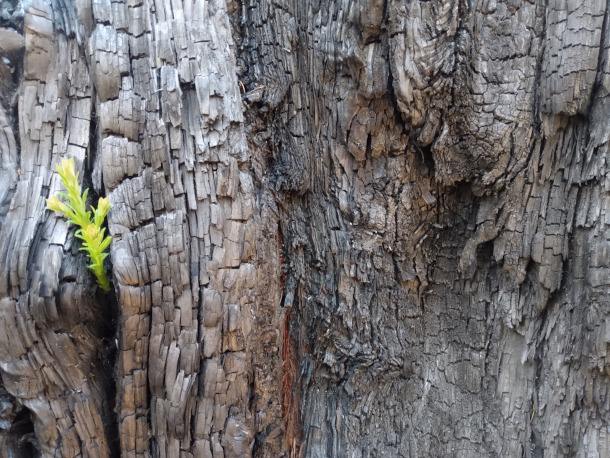
A small sprout emerging from a very large redwood. (Photo: Drew Peltier)
DOERING: And it sounds like if these buds are just sprouting now, all this time, they've been lying dormant, they go all the way back to in some cases when that tree first sprouted. So, somehow, it sounds like the tree knew, you know, this is my savings account. I need to keep this around in case I need it someday and this is the moment.
PELTIER: Yeah, I mean, I guess that's one way to think about it for sure. A useful comparison, I think, is to the giant sequoia in California, so these are the other giant tree species that lives in California. They unfortunately do not have the civility to do this resprouting thing. And a lot of those trees actually burned as well in 2020 and also in 2021. And those two fire events combined, I think, killed around 15% of the largest giant sequoia in California. So, 15% of the largest died sequoia on Earth because essentially, when those trees lose all their leaves that's it, its game over. So, this resprouting adaptation, this maintenance of buds for really long time periods is a super important adaptation and seems like too extreme wildfire.
DOERING: So not all trees can do this.
PELTIER: Definitely not. It's pretty common in you know, what we call broadleaf trees. You know, what you think about in the East with the autumn colors, things like maples and hickory, lots of those trees, particularly oaks will resprout from the base. It's almost entirely absent in pines and it seems to be a thing and the Cupressaceae so this is stuff like junipers, cypress, redwood.
DOERING: So, you mentioned these carbon stores that are really old. That's the way that these trees were able to grow new tissue, new green needles after this fire. Where exactly are they storing this and how?
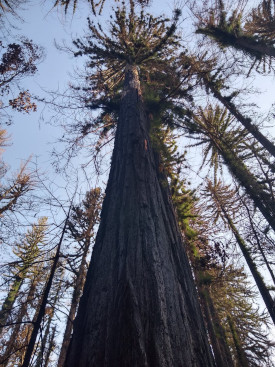
A giant sequoia where Drew Peltier installed a phenocam, a digital camera used to monitor ecosystem dynamics over time. Many giant sequoias are between 250 and 300 feet tall, the tallest being about 325 feet high. (Photo: Drew Peltier)
PELTIER: Yeah, so. Everywhere is the answer to that question, in all living cells. You know, animals have fat cells that's how you know you and I and my dog store our energy, but plants do not have that. Some of them store lipids but mostly they store energy in the form of sugars and starches and those are stored pretty much throughout the tree. Some trees have specialized below ground organs but in redwoods it's everywhere in living cells. So, in branches and leaves, in the stem and roots, but the oldest reserves seem to be in really, really deep tree rings.
DOERING: So how did you actually figure out how old these stored carbon reserves were?
PELTIER: Yeah, so we did a bunch of sampling for this study but the main thing we did was simply just to collect some of these little sprouts. So, Lissu Enright is co-author on our paper, was out there in just a couple of months after the fire and she covered parts of the bark, basically, to keep those sprouts from photosynthesizing. So, they only were drawing on stored carbon reserves. And then we just sort of clipped them when they got big enough and use them for analysis. And so, the way that we actually figure out the age of the reserves that were used to build those sprouts, is based on what's called radiocarbon dating. And so, the way to think about this is kind of, by using a bookmark and the bookmark and time is basically atmospheric bomb testing in the 50s, and 60s. And so, you know, this was a pretty strange period in human history but one thing that did happen was we basically doubled the concentration of radiocarbon in the atmosphere. Since that time, we've stopped testing nuclear bombs in the atmosphere, which is great and so as a result, that concentration of radiocarbon has dropped off over time. And so, what we can do is simply just look at the carbon that's in this little sprout and see how much radiocarbon is there now using what's called accelerator mass spectrometry. And by comparing it to that kind of annual record that we have of radiocarbon, we can estimate how old it is. And so, I say how old but what I really mean is that's a that's a measure of how long it's been since that carbon was photosynthesized from the atmosphere. It's a measure of sort of how long that sugar has been sitting in that tree before it was used.
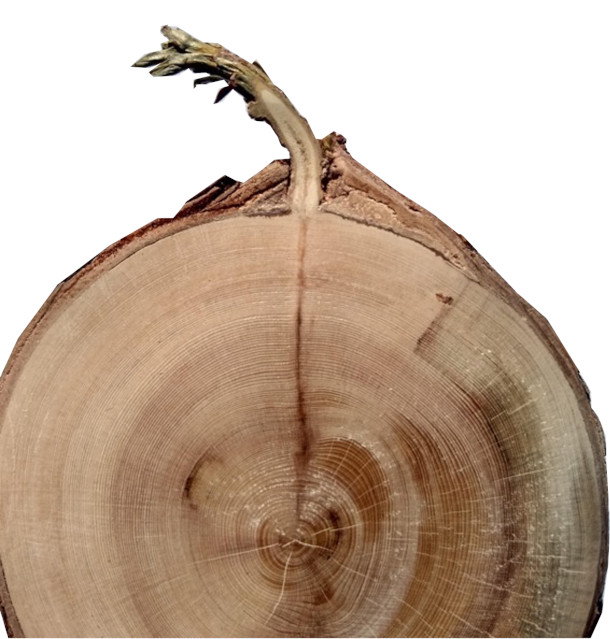
This is a cross section of a branch showing the "bud trace" of a sprout. These same structures are present on the main stems of these resprouting redwoods, showing the buds that grew these sprouts may be thousands of years old. (Photo: Drew Peltier)
DOERING: So how does your research add to previous knowledge of tree growth?
PELTIER: So, we have a lot of models of the global climate system, and what are called dynamic global vegetation models, or terrestrial vegetation models. And a lot of these make certain assumptions about how tree growth works because tree growth is a really important process in the global carbon cycle. Forests pull huge amounts of carbon out of the atmosphere every single year and so kind of having a good handle of that and being able to predict that process going forward is a really important constraint on atmospheric carbon dioxide, basically. One assumption of many, many models about how tree growth works is that there's basically little or no storage of photosyntheic or carbon reserves over time. And so, what we've shown is not only are there really really old reserves present in these very old trees, but also, they're pretty substantial amounts of them. So, in one estimate, it seems possible that they were perhaps hundreds of kilograms of 50-year-old carbohydrates in these trees, in the old ones. And so that's like a small motorcycle of sugar from 50 or 60 years ago. That's a pretty big amount.
DOERING: Yeah, that is fascinating. So not only is this a story about how these forests are being affected by climate change induced impacts, like wildfires that are getting worse, but also, we're learning potentially how we can improve our climate models.
PELTIER: Definitely, there's one more research that I'm doing at least, this is something I work on that basically shows that trees have the so-called memory of past climate, and they respond to their environment over really long timescales because they live a really long time. And so, this storage of carbon reserves is one mechanism for how that works. So, we know for example, drought can leave really long legacies on tree growth where trees grow more slowly for up to five years after drought events. And so, they're similar examples of that in the literature but this is sort of how that works basically. Trees are doing photosynthesis all the time, they're putting energy into this kind of gas tank of sugars and starch and they're using it to grow at different times. And when times are bad, maybe they draw a little bit more on this gas tank and when times are good, maybe they put more in. But what this study shows is that there are really really old energy reserves in that pool of carbon, at least in old trees. You know, some of these trees were upwards of 2000 years old.
DOERING: What does it feel like to study trees with such long lifespans compared to ours?
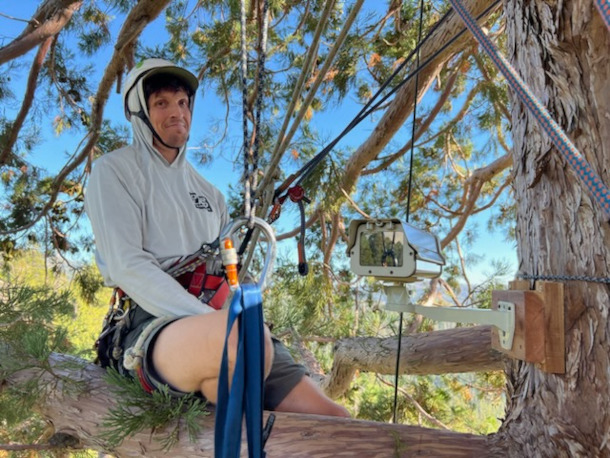
Drew Peltier at the top of a giant sequoia installing a new phenocam to monitor some fire impacts in the Mariposa Grove in Yosemite National Park. (Photo: George Koch, co-author of the study “Old Reserves and Ancient Buds Fuel Regrowth of Coastal Redwood After Catastrophic Fire”)
PELTIER: Well, I can answer that experience I had recently in a different tree species, but recently I was in Yosemite in the Mariposa Grove in giant sequoia trees basically and we got the opportunity to collect some tree cores. And I took a tree core from one of these giant sequoia that was just really, really big and on all these fire scars. And when I took the car out it became immediately obvious, you can tell when the rings are really, really small and really, really close together, that this tree was just thousands of years old, and I cried basically. It was just a really emotional experience for me. I mean, they're, you know, I think everyone has to go to these old growth redwood groves and giant sequoia because the pictures just do not do it justice. You know, when you go, I assume you'll have the experience of trying to take a picture on your phone and you just can't capture it unless there's like a bus in there or something for scale. They are just kind of beyond belief in terms of how large they are and they're really just magical, really important places that I think we need to preserve.
DOERING: Drew Peltier is an Assistant professor in the School of Life Sciences at the University of Nevada, Las Vegas. Thank you so much, Drew.
PELTIER: Thanks very much for having me. It was great to chat with you.
Related links:
- Nature Plants | “Old Reserves and Ancient Buds Fuel Regrowth of Coastal Redwood After Catastrophic Fire”
- Learn more about Drew Peltier
[MUSIC: Neena Goh “Only Time (Instrumental)”]
La Niña and El Niño Dance
A La Niña weather pattern starts with colder-than-average temperatures in the Pacific Ocean, and results in climate shifts across the North American continent and other parts of the world. (Photo: NOAA.gov, public domain)
DOERING: Alongside the long-term trend of climate disruption, there are climate patterns that can enhance or sometimes mask the overall warming climate. One of these cycles is a phenomenon known as the El Niño Southern Oscillation. El Niño is Spanish for “little boy,” and it’s called that because it usually arises in the Pacific Ocean off the coast of South America sometime around the longest day of the year in the southern hemisphere. That’s also right around when Christians celebrate the birth of the “Christ child.” Some years, warmer-than-average temperatures spell an El Niño, and in others colder-than-average temperatures mean a La Niña. And Aynsley, you’ve been taking a look into the news that we’ve just entered La Niña and what that means for the climate. So, what did you find?
O’NEILL: Yeah Jenni, we’ve just recently dipped from neutral territory into a weak La Niña, meaning that the sea surface temperature is 0.5 degrees Celsius colder than average. When seas are 1 degree colder than usual, that’s a moderate La Niña, and so on, and so forth.
DOERING: Okay, so if we’re in a weak La Niña, it must not be that intense right now.
O’NEILL: Right, although as with everything it’s a little more complicated. Climate expert Kevin Trenberth is now retired from a career with the US National Center for Atmospheric Research. And he wrote to me that in many ways it actually looks like a more moderate La Niña, because the rest of the sea temperatures are above what we consider normal due to the warming planet.
DOERING: Huh, makes sense. What’s ‘average’ is changing now. So, what does this La Niña mean for the weather we see not just in the ocean, but on land?
O’NEILL: Well, one of these events dictates a lot regarding rainfall patterns.
So, in North America, we’re seeing wetter conditions in the pacific northwest and up to British Columbia, and drier conditions in the American southwest.
DOERING: And there would also be an impact on temperature, right?
O’NEILL: Yeah, generally speaking, winter temperatures are going to be cooler than normal in the Northern U.S. and warmer than normal in the Southern U.S. Those changes are at their peak between November and February - which is why you’ll usually see one of these events listed under two years. And the cold La Niña events will often double- or triple-dip, lasting for two or three years, but El Niño tends to stick to one.
DOERING: Hmm. I can’t help but think that La Niña with its hotter, drier weather doesn’t sound like good news for Southern California and the terrible wildfires there right now.
O’NEILL: No, not at all.
DOERING: And of course, this La Niña is unfolding in an ever-changing climate.
O’NEILL: That’s right, and while scientists aren’t sure exactly how climate disruption is impacting the El Niño / La Niña cycle, warming global temperatures are definitely resulting in more intense effects of an El Niño or La Niña. Droughts are drier, rainy seasons are wetter.
DOERING: Hmm.
O’NEILL: And just because La Niña means colder-than-average ocean surface temperatures doesn’t mean that it’s reversing global warming or anything - if you look at the NOAA data, you can see that the ocean surface temperatures during recent La Niña years are actually warmer than for the El Niño years in earlier decades.
DOERING: So, La Niña won’t necessarily bring a reprieve from the record-breaking temperatures we saw in 2024.
O’NEILL: Nope – so, we are likely in for another very hot year in 2025.
DOERING: Ugh. Indeed.
Related link:
More on La Niña from National Geographic
[BIRDNOTE THEME]
BirdNote®: Waxwing Nightlight
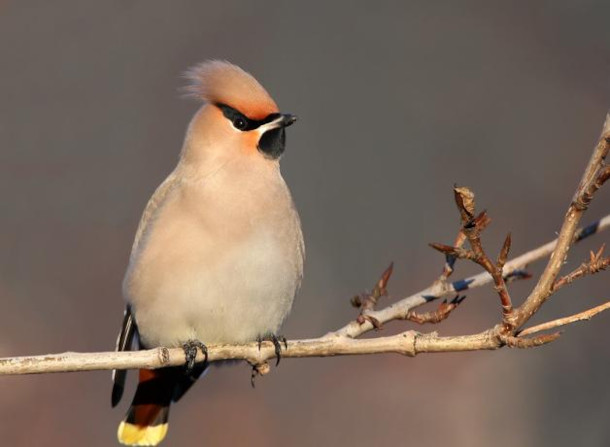
The bright coloration of bohemian waxwings led people to believe that the birds could glow in the dark. (Photo: © Sindri Skúlason, courtesy of BirdNote®)
DOERING: Brilliant red winterberries shine amid the muted tones of this season, and throughout the winter they feed fruit-loving birds like waxwings. But as BirdNote®’s Mary McCann tells us; the birds themselves were once believed to shine even brighter.
BirdNote®
Waxwing Nightlight
Written by Rick Wright
MCCANN: For the better part of two thousand years, the waxwing was credited with an amazing power.
[Richard Wagner, Siegfried-Idylle]
[Bohemian Waxwing calls and “song,” ML 170762, 04:26 and following]
It was believed in all earnestness that these gentle, crested fruit-eaters glowed in the dark.
Pliny reported that their feathers were said to “shine like flames” in the dark forests of central Europe. The Latin scholar Solinus went further: Not only did waxwings throw off a warm glow, he said, the Germans used captive birds to light their way when they were obliged to travel by night.
[Richard Wagner, Siegfried-Idylle]
But at the end of the sixteenth century, the great Italian bird man Ulysses Aldrovandi was skeptical. In his twelve-volume encyclopedia of ornithology, Aldrovandi admits that the waxy red tips on the bird’s wing feathers are beautiful, but he dismisses the notion that they give off any kind of light.
How could he be so sure?
“For nearly three months,” he writes, “I kept a waxwing alive in my house and observed it through the night.” He goes on to note the bird stubbornly failed to emit flames or light of any kind.
Today, no one thinks that waxwings glow in the dark. But that doesn’t stop these winter nomads from brightening the birdwatcher’s day.
[Richard Wagner, Siegfried-Idylle]
[Bohemian waxwing calls and “song,” ML 170762, 04:26 and following]
I’m Mary McCann.
###
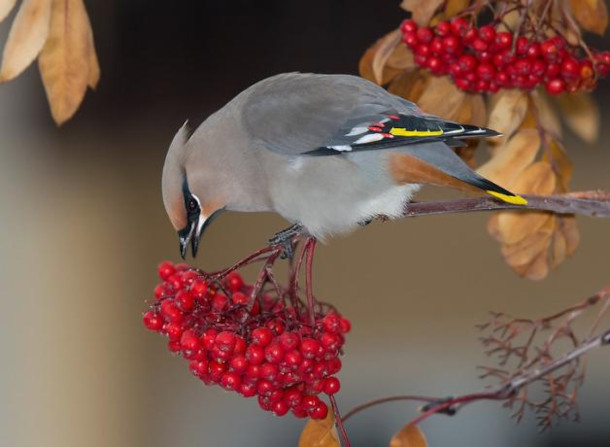
A bohemian waxwing picks at a red berry. (Photo: © Keith Williams CC, courtesy of BirdNote®)
Bird sounds provided by The Macaulay Library of Natural Sounds at the Cornell Lab of Ornithology, Ithaca, New York. Bohemian Waxwing, ML 170762, recorded by David A. McCartt.
Richard Wagner, Siegfried-Idylle. youtube.com/watch?v=891JUSQplzU Performed by Sergiu Celibidache and the Münchner Philharmoniker.
BirdNote’s theme music was composed and played by Nancy Rumbel and John Kessler.
Senior Producer: Mark Bramhill
Producer: Sam Johnson
Content Director: Jonese Franklin
© 2015 Tune In to Nature.org December 2015/2018/2020 November 2024 Narrator: Mary McCann
ID# BOWA-03-2015-12-30 BOWA-03
https://www.birdnote.org/podcasts/birdnote-daily/waxwing-nightlight
DOERING: For pictures, fly over to the Living on Earth website at loe dot org.
Related link:
This story on the BirdNote® website
O’NEILL: Just ahead – making roads safer for wild animals. Keep listening to Living on Earth.
ANNOUNCER: Support for Living on Earth comes from Friends of Smeagull the Seagull and Smeagull’s Guide to Wildlife. It’s all about the wildlife right next door to you! That’s Smeagull, S - M - E - A - G - U - L - L, SmeagullGuide.org.
[CUTAWAY MUSIC: Ron Carter/Gerry Gibbs/Kenny Barron, “Reasons” on Jazz Interpretations of R&B Classics, by Earth, Wind & Fire, Whaling City Sound]
Crossings: How Road Ecology is Shaping the Future of Our Planet
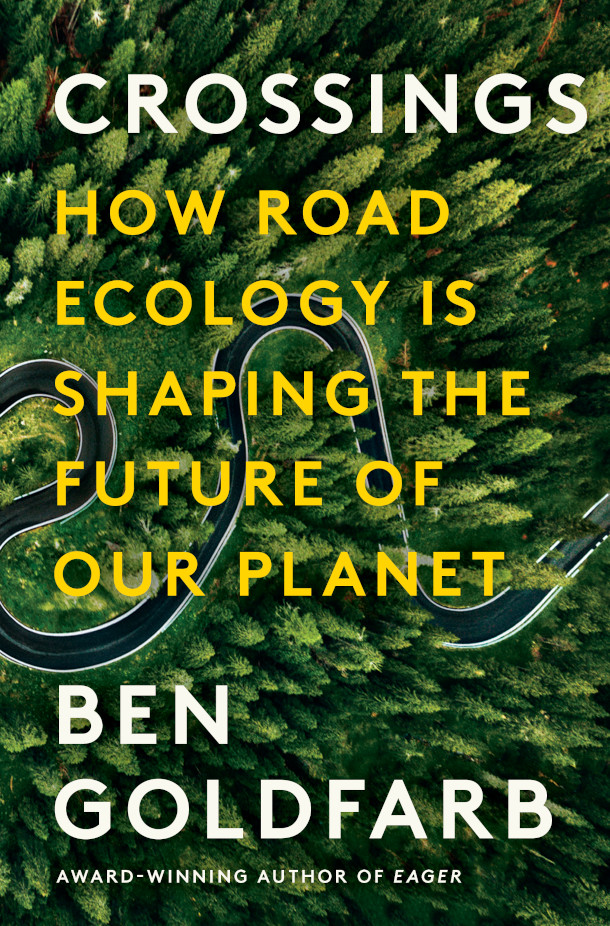
Crossings explores the way that our roads impact wildlife and what we can do about it. (Photo: Courtesy of Ben Goldfarb)
O’NEILL: It’s Living on Earth, I’m Aynsley O’Neill.
DOERING: And I’m Jenni Doering.
The many millions of miles of roads that crisscross our planet allow us humans to get from Point A to Point B. But they make it a lot harder for the other animals we share the Earth with to get around. Fortunately, there’s a whole branch of ecology dedicated to making roads a little friendlier to wild animals, and journalist Ben Goldfarb explores it in his book “Crossings: How Road Ecology is Shaping the Future of Our Planet”. I started by asking Ben to read a passage from his book.
GOLDFARB: Road ecology was an act of inter-species imagination, a field whose radical premise asserted that it was possible to perceive our built world through nonhuman eyes. How does a moose comprehend traffic? What sort of tunnel appeals to a mink? Why do grizzly bears prefer crossing over highways while black bears go under? These questions had empirical answers, but they also required ecologists to think like wild animals—empathy manifested as science.
DOERING: Ben, that kind of thinking seems rare in our hyper anthropocentric world.
GOLDFARB: It does. Yeah, you know, and I think that's especially true when it comes to roads, that roads are these ubiquitous structures. We don't really think about them a whole lot. One of the beautiful things about road ecology is that, in a way, one of the guiding principles is to think about our human built landscapes the way that wild animals might think about them. Those non-human beings perceive our roads and railroad tracks and container ships and so on, so differently than we do. That idea of trying to comprehend our built world through the eyes of non-human beings, it's a really powerful idea. And in a sense, even though I'm not sure road ecologists would explicitly say they're doing that, that's what this field of science is all about.
DOERING: Of course, roads cause all kinds of ecological disruptions, but the most obvious and really tragic is roadkill itself. Just how big of a problem is roadkill in the United States?
GOLDFARB: It's almost unfathomably vast as an issue. We don't really know exactly how many animals are killed every day by cars, but the best guess is that more than a million vertebrate animals, so to say nothing of insects and arachnids are killed by cars every day. I think we have this way of saying, "well, look, lots of common animals like gray squirrels and raccoons and white-tailed deer are being hit by cars, but there are a lot of squirrels and raccoons out there. So yes, it's sad for those individual animals, but it's not really a conservation crisis," because logically enough, the animals that we see dead on the highway are the common animals. But there are lots of threatened and endangered species too, like Florida panthers and ocelots and tiger salamanders, for which roadkill is the leading source of mortality. There are many, many species in the US and around the world that we're literally driving to extinction.
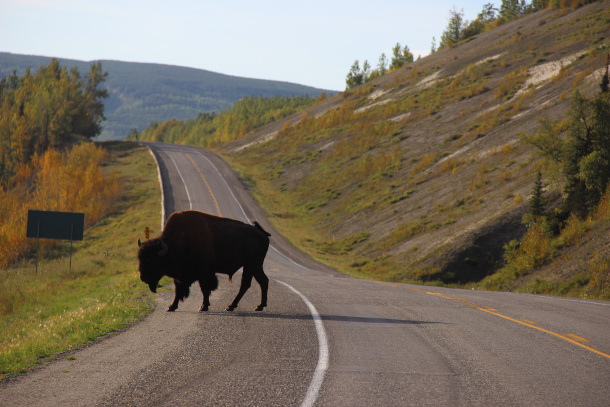
Although we typically see common animals as roadkill, endangered species are also at risk of getting hit by cars. (Photo: Courtesy of Ben Goldfarb)
DOERING: So, Ben, different animals respond differently to the presence of traffic. How might a bear's response compared to a deer or even a frog?
GOLDFARB: Yeah. So, it's a great question, and a few years ago, a group of road ecologists, led by a scientist named Sandra Jacobson, classified animals responses to roads because every animal experiences roads differently and reacts differently to them. So, on one end of this spectrum of road response, you have animals that have been called non responders, animals that don't really notice or react to traffic. There, we're talking largely about reptiles and amphibians. You can imagine a bunch of frogs on a warm, wet spring night hopping down to their breeding pond to mate, and they're just going for it. Any road that's in their way; they're going to cross it. They don't necessarily know that traffic means trouble, and they get crushed in enormous numbers. They're these, you know, mass squishing events, where hundreds or even 1000s of frogs and salamanders can be killed on a single night because they're not responding to the presence of traffic. So, there you've got the non-responders, the animals are just crossing the road come, you know, hell or high water. And then on the other end of the spectrum, we've got road avoiders, really cautious, wary animals, and grizzly bears are kind of the iconic example of that. These are really intelligent animals who rightfully know that roads are dangerous and that humans use roads and humans are dangerous, and even a handful of cars per hour can be enough to prevent grizzly bear from crossing a relatively rural road, and so they don't get hit by cars as much. But you know, I think for bears, you know, almost a bigger problem than roadkill is habitat fragmentation, because they're not crossing these roads at all. They're unable to find mates, find all the food they need. We know that road density is one of the biggest factors in making habitat unsuitable for grizzly bears. So, whether you're crossing the road too often, in the case of amphibians, or not crossing at all, in the case of many grizzly bears, roads spell trouble.
DOERING: And then there are animals in the middle, like deer, that will approach the road cautiously, and then when they think it's safe to go, they'll go across. But of course, we see a lot of deer collisions in the US, and that can be a huge problem, not just for the deer, the very tragic outcome of that for them, but also for us humans.
GOLDFARB: Absolutely. Yeah. So, deer, scientists have called speeders, which means that they're looking for these little gaps in traffic that they can run through. And of course, they don't always gage those gaps perfectly. And obviously, deer collisions are the result of that. There's something like a deer collision every 30 seconds in the US. Large animal collisions collectively cost society more than $8 billion in hospital bills and vehicle repairs and insurance costs and so on. And hundreds of drivers die every year, and deer crashes and other large animal crashes, the white tail deer is the single most dangerous wild animal in North America. That's not the deer's fault; that's the car's fault.
DOERING: Wow. Forget about bears or wolves or cougars. It's the deer you need to watch out for.
GOLDFARB: Exactly, in fact, there have been studies suggesting that return of wolves and cougars could ultimately be a really good thing for human safety because they would thin some of those overpopulated deer herds and prevent a lot of dangerous crashes.
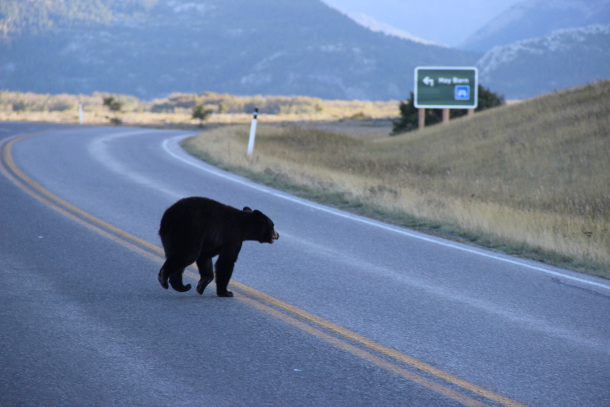
Black bears generally prefer to use underpasses that are built under highways than use overpasses, which function more like bridges. (Photo: Courtesy of Ben Goldfarb)
DOERING: So, if you go on a road trip these days, you might go underneath one of these amazing structures called an overpass, or you might, you know, not even realize you're driving right over a lot of underpasses. What goes into thinking about what makes for an effective wildlife crossing when it is an overpass or an underpass?
GOLDFARB: Yeah, really good question. So, you know, I think the most important thing to start thinking about is, okay, what animals are you trying to help? Because there are some animals, like deer, that will very happily go through an underpass. But then there are other species that really prefer overpasses, going over what it looks like to us, like a pedestrian bridge, basically over a highway. A really good example of that are pronghorn, which are commonly known as antelope. And pronghorn are the prototypical overpass users. They're incredibly fast, right? They're the fastest land animal in North America. They've got amazing vision. They can see a really long distance. So, they don't want to be crawling through a little culvert. They want to be up on the deck of a bridge where they can look out for predators and run away if they have to. So, if you're going to build a wildlife crossing for pronghorn, you know, you really want an overpass, right? So that's just, you know, one example of how you really have to think about the animals you're trying to help and, of course, figuring out where the animals would want to cross the highway if they could right? And so, we're looking, typically, at road collision data. You know, if there's a big pile of carcasses, that's probably a pretty good indication that there's a migration route crossing the highway, and putting those satellite collars on animals, tracking wildlife to figure out where they're approaching highways and might want to cross if there is an opportunity to cross, that's another really helpful data layer. So, it's that combination of things. What animals are you trying to help? Where are the animals approaching the highway? All of those different factors are going into, you know, where these wildlife crossings are sited.
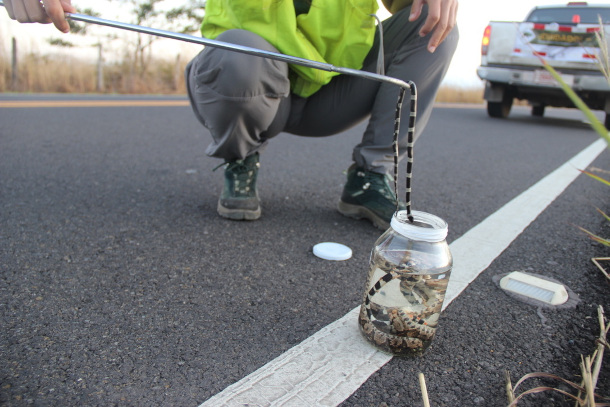
Though mammals are the most visible form of roadkill, cars also decimate populations of various reptiles and amphibians. (Photo: Courtesy of Ben Goldfarb)
DOERING: Now, talk to me about migration, and how species that migrate often come into some of these road conflicts, more so than species that stay in one place.
GOLDFARB: Absolutely. So, you know, what is the point of migration? Right? The idea of migrating, if you're an organism, is to sync your movements with the resources that the world provides you. So, one chapter of this book, for example, is about mule deer in southwestern Wyoming. These deer are migrating between seasonal habitats. In winter, they're down in these low elevation valleys where there's not a whole lot of snow and the weather's a little bit gentler. And then in summer, they're following this green wave of new vegetation up into the mountains to spend the summer browsing up in the cool High Country. So, if you're a mule deer, you're following those seasonal resources is integral to your survival. The problem is that there's no spot in the lower 48 states that's farther than 20 miles from a road. So, if you're going to migrate, roads are going to get in the way. And in the case of those mule deer, their winter range is basically bisected by I80, this giant interstate highway. And during really harsh years, you know, they'll basically pool up against the North side of I80 looking for a way to cross to find that good winter food that they need to survive. Some especially harsh years, 40% of that deer herd will actually starve because they can't complete their migration to reach all of that really good winter range on the south side of I80. So, that's, I think, a really powerful example of how migration historically, this brilliant strategy, has become increasingly dangerous or problematic because of roads. And those migratory species, which were historically some of the most successful animals on earth, are today really endangered in many cases.
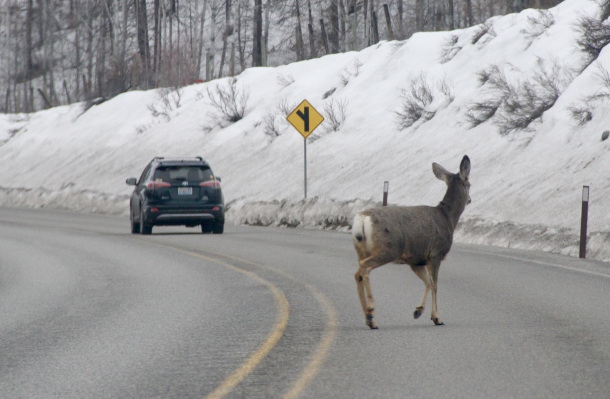
Deer are considered the most dangerous vertebrate in the United States because of the number of people who die in deer-car collisions per year. (Photo: Courtesy of Ben Goldfarb)
DOERING: So, Ben, you put in a wildlife crossing, an overpass or an underpass, the animals need to know that they're supposed to use it. So how do you direct them towards this overpass or underpass?
GOLDFARB: Yeah, so the really critical infrastructure that gets the animals to the crossings are roadside fences. You're fencing off the highway on either side of the crossings and basically guiding the animals to the crossings. And what happens over time, in many cases, that animals just incorporate those crossings in their movements, and they acclimate to them. And you know, a herd of deer will learn to include the crossing in their migration route, or a grizzly bear will teach her cub how to use crossings, and then her cub will become a crosser. But it really all starts with fences that are just keeping the animals off of the highway and getting them to those crossings. So, in a sense, those two pieces of infrastructure, the fences and the crossings, don't really work without the other, right? If all you did was fence the highway, then you'd prevent roadkill, but you wouldn't let animals migrate and meet each other, and if you put up crossings, but no fences, then the animals wouldn't necessarily know to use them.
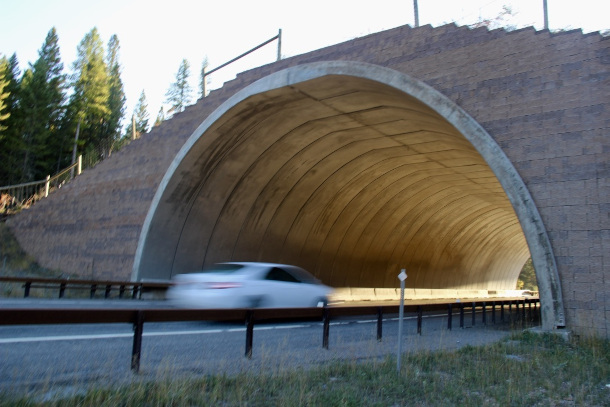
Overpasses are the most visible form of wildlife crossing, allowing animals to walk over the highway. (Photo: Courtesy of Ben Goldfarb)
DOERING: You visited a number of these wildlife crossings, overpasses, underpasses, in the course of writing this book, what's the one that stuck with you the most?
GOLDFARB: Well, it's funny. I mean, the one that I think about a lot, perhaps because it's the, you know, one of the most famous wildlife crossings out there is one that doesn't totally exist yet, or at least one that's not completed yet, and that's the Liberty Canyon crossing just outside of Los Angeles that's being built for mountain lions. And the situation there is, there's this little population of mountain lions trapped in the Santa Monica Mountains, surrounded by this ocean of freeways totally cut off from the rest of mountain lion society elsewhere in California. And so, there's a wildlife crossing being built over the 101, the busiest freeway on Earth, that would allow those mountain lions to mingle with cats elsewhere in the state, and refresh that gene pool and keep that little population alive. And that's an incredible project, I think, because there, it's they're just doing so much to essentially create a new ecosystem atop the highway. The thing about the 101, is that, because it's so densely traffic, so much noise and light pollution, that the designers of that crossing are really pulling out all the stops to create an enticing environment. If you're building a wildlife crossing over a little two-lane highway in Wyoming, you don't necessarily have to take all of these measures, but with such a busy freeway in Los Angeles, you really have to do a lot to make it appealing, and so they're adding all of these vegetated screens and berms and rock walls to block some of that sensory pollution. They're growing plants at an on-site nursery to create this vegetation community atop the wildlife crossing. So, they're really just again, creating this new chunk of land atop the highway that will resemble the surrounding ecosystem. And to me, that's just such a beautiful idea creating a new ecosystem over a highway. That just blows my mind.
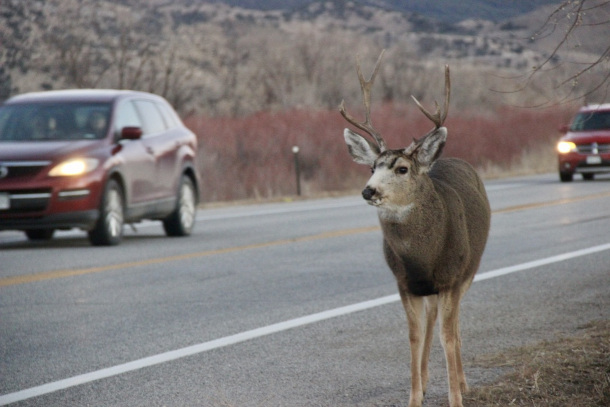
Animals that avoid crossing roads may not get hit by cars, but they sometimes die because they can’t migrate to areas with more food or fail to reproduce if they are unable to cross the road to find a mate. (Photo: Courtesy of Ben Goldfarb)
DOERING: And this crossing Liberty Canyon started in part because the public fell in love with a very famous kitty, a mountain lion named P-22. Can you tell us his story?
GOLDFARB: Right, so, P-22 is the poster cat for this whole project. And so, P-22 was born in the Santa Monica Mountains, this little patch of habitat isolated by freeways. And he was, you know, one of the only cats that managed to get out of there. He managed to cross the 101 and the 405 these two incredibly busy freeways. Somehow, nobody's quite sure how he did it. And he ended up in Griffith Park, which is this, you know, tiny little island of wildness, really, in Los Angeles proper. You know, that's where the LA Zoo is, and the Hollywood sign. And P-22 lived there successfully for many years. He never bothered people. He hunted deer and raccoons at night. He was this wonderful neighbor.
DOERING: Didn't he break into the zoo at times though?
GOLDFARB: He did, he did kill a koala in the zoo. I think that's actually kind of incredible. I think in many places, they would have said, Oh, we can't have this wild, big cat menacing our precious zoo animals. But, you know, instead, to Los Angeles' credit, they said, well, we'll just sort of fortify the zoo itself, and we'll let P-22 do his thing. And so, he really captured people's imagination. But it was also sad story as well because he was isolated in this little park and was doomed never to find a mate. It was very unlikely that any female mountain lion would ever repeat that journey and end up in Griffith Park. So, he was doomed to be this lonely bachelor for the rest of his life. And so, I think that idea of this cat who is looking for love but trapped on this little island of habitat surrounded by an ocean of freeways, I think that captured people's imaginations and activated that ecological empathy we were talking about earlier. And thanks to the campaigning and fundraising efforts of a woman named Beth Pratt with the National Wildlife Federation and many other people as well, this wildlife crossing is being built now. And unfortunately, P22 died a couple of years ago. He was actually hit by a car and injured had to be euthanized. But this wildlife crossing is going to help his literal flesh and blood family members who still live in in the Santa Monica Mountains. So, it's, you know, I think, a pretty incredible example of how a charismatic animal can really galvanize public support.
DOERING: And by the way, how much is this wildlife crossing going to cost in the end, and when will it be ready?
GOLDFARB: Yeah, it's gonna end up being over $90 million in part, again, because, you know, it is the largest one ever being built, and they're really are pulling out all the stops. That's a pretty atypical price tag for wildlife crossings, typically with an overpass, we're talking more like eight to ten million dollars, so definitely don't want people to see the $90 million price tag and say, "Oh well, they all cost that," because the Liberty Canyon crossing really is exceptional, very unusual, and last I heard, it'll be complete in early 2026.
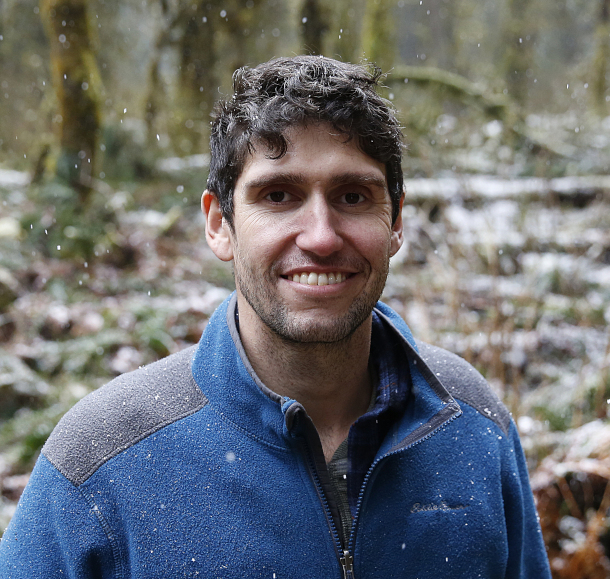
Ben Goldfarb is the author of Crossings: How Road Ecology is Shaping the Future of Our Planet. (Photo: Terray Sylvester)
DOERING: Now, of course, most of your book focuses on what's happening here in the US, but you also do travel to other countries. What have you seen in terms of who's at the forefront of this field of road ecology and making sure that the environment more safely interacts with our roads?
GOLDFARB: You know, it's interesting here in the US, we have this very calcified highway system, right? We built our highways in the 1960s and 70s, at least, you know, our big interstates before we fully recognized what a gigantic problem we were creating for wildlife. So, most of the work that we're doing here in the US is basically retrofitting right, adding wildlife crossings here and there, whereas other countries, especially developing countries, that are building out their highway infrastructure now, you know, they can do it right from the get go. India is a really good example of that. And in some places, India has built highways up on these concrete pillars, so the whole highway is elevated above the forest floor, and tigers and elephants and other animals can wander back and forth unimpeded. So, the great challenge is that a lot of these countries that are building their highways now aren't necessarily doing that. We're in the middle of this period that the ecologist Bill Lawrence has called the infrastructure tsunami, — you know, this wave of new construction that's sweeping across the planet, especially in places like India and Nepal and Brazil, some of the most biodiverse countries on earth. And just the sheer number of highways that are being built right now, I think, really threatens to overwhelm nature. So, we're at this critical point in the history of infrastructure where we're building more of it now than ever. It's really the primary threat to so many different species, especially in the tropics, and we really need to get it right, because obviously some amount of highway building is unavoidable and even desirable, but how can we do that in a way that doesn't totally sacrifice nature? I think that's one of the next great challenges in human history.
DOERING: Ben Goldfarb is an environmental journalist and the author of Crossings: How Road Ecology is Shaping the Future of Our Planet. Thank you so much, Ben.
GOLDFARB: Thanks, Jenni, it's great to be here.
Related links:
- Explore Ben Goldfarb’s work
- Purchase Crossings: How Road Ecology is Shaping the Future of Our Planet and support both Living on Earth and local book stores.
- Learn more about the Liberty Canyon Wildlife Crossing.
[MUSIC: Speedo Harmonica Jones, “Rockin For Red” (Dedicated to Red Prysock) on Indescribably Blue, by Speedo Harmonica Jones, Self-published and distributed]
O’NEILL: Next time on Living on Earth, “How to make healthier choices in the produce aisle?”.
TERRY: What we can say, which is very related to organic food consumption, is that many pesticides are known carcinogens. Since organic food do not contain the pesticides that you would see in some other foods, eating organic would be preferable if you can reduce your exposures to pesticides.
O’NEILL: Tune in to hear more about organic food and cancer prevention, next week on Living on Earth.
[MUSIC: Oskartello, Felix Hien, “Papayas” on Soul Fruits, Fortune Cookie Records]
O’NEILL: Living on Earth is produced by the World Media Foundation. Our crew includes Naomi Arenberg, Paloma Beltran, Kayla Bradley, Daniela Faria, Mehek Gagneja, Swayam Gagneja, Mark Kausch, Mark Seth Lender, Don Lyman, Nana Mohammed, Sophia Pandelidis, Jake Rego, Andrew Skerritt and El Wilson.
DOERING: Tom Tiger engineered our show. Alison Lirish Dean composed our themes. You can hear us anytime at L-O-E dot org, Apple Podcasts and You Tube music, and like us, please, on our Facebook page - Living on Earth. We tweet from @livingonearth. And find us on Instagram at livingonearthradio. And we always welcome your feedback at comments at loe.org. Steve Curwood is our Executive Producer. I’m Jenni Doering.
O’NEILL: And I’m Aynsley O’Neill. Thanks for listening!
ANNOUNCER: Funding for Living on Earth comes from you, our listeners, and from the University of Massachusetts, Boston, in association with its School for the Environment, developing the next generation of environmental leaders. And from the Grantham Foundation for the protection of the environment, supporting strategic communications and collaboration in solving the world’s most pressing environmental problems.
ANNOUNCER 2: PRX.
Living on Earth wants to hear from you!
Living on Earth
62 Calef Highway, Suite 212
Lee, NH 03861
Telephone: 617-287-4121
E-mail: comments@loe.org
Newsletter [Click here]
Donate to Living on Earth!
Living on Earth is an independent media program and relies entirely on contributions from listeners and institutions supporting public service. Please donate now to preserve an independent environmental voice.
NewsletterLiving on Earth offers a weekly delivery of the show's rundown to your mailbox. Sign up for our newsletter today!
 Sailors For The Sea: Be the change you want to sea.
Sailors For The Sea: Be the change you want to sea.
 The Grantham Foundation for the Protection of the Environment: Committed to protecting and improving the health of the global environment.
The Grantham Foundation for the Protection of the Environment: Committed to protecting and improving the health of the global environment.
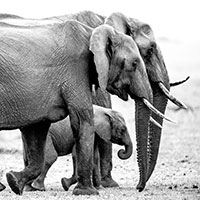 Contribute to Living on Earth and receive, as our gift to you, an archival print of one of Mark Seth Lender's extraordinary wildlife photographs. Follow the link to see Mark's current collection of photographs.
Contribute to Living on Earth and receive, as our gift to you, an archival print of one of Mark Seth Lender's extraordinary wildlife photographs. Follow the link to see Mark's current collection of photographs.
 Buy a signed copy of Mark Seth Lender's book Smeagull the Seagull & support Living on Earth
Buy a signed copy of Mark Seth Lender's book Smeagull the Seagull & support Living on Earth

